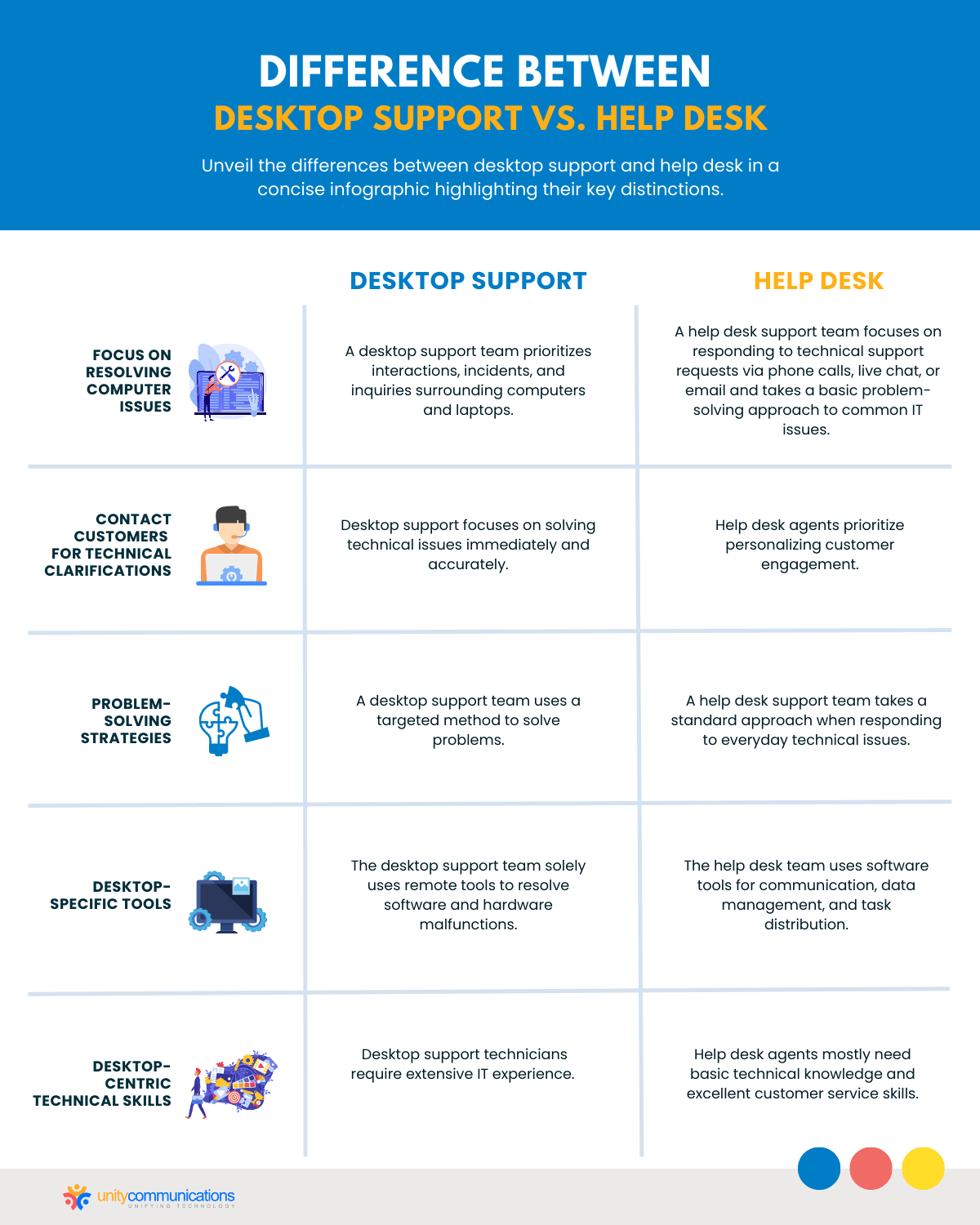Table of Contents
Computer users facing system errors rely on a desktop support team to fix the issues that arise. Typically, though, they first contact a help desk to relay their concerns and seek assistance. This is where the confusion begins for businesses that want to invest in information technology (IT) support outsourcing.
Many companies use the terms “desktop support” and “help desk” interchangeably due to their similar customer interaction processes. These functions, however, have remarkably different scopes, goals, strategies, and technologies.
This article explains what desktop support is and how it differs from help desk support.
What Is Desktop Support?
Desktop support is a back-office outsourcing service where technicians provide direct assistance to computer users. Businesses often treat desktop support and help desk support as two similar functions. But these two processes are different in terms of priorities, objectives, and work strategies.
Desktop support and help desk support are two types of technical support services. A help desk unit focuses on answering common IT inquiries. A desktop support team directly handles technical issues concerning computers and laptops.
Desktop technicians perform the following tasks remotely or in person:
- Troubleshoot software and network errors
- Install and configure software apps
- Track and eliminate malware
- Recover blocked or hacked desktop accounts
- Repair defective printers and scanners
- Fix damaged computer hardware
- Monitor, assess, and maintain desktop system performance
- Roll out regular system updates
- Perform backups and recover data
- Manage server performance
- Deploy and integrate desktop solutions
- Organize security patches
Five Ways Desktop Support Differs From a Help Desk

Back-office outsourcing offers an affordable solution to rapidly and effectively solve desktop issues. Before hiring a business process outsourcing (BPO) company, however, you must identify the technical support you need so that you can correctly describe to the outsourcing company the specific services you need. This helps achieve cost reduction and appropriate specialized service.
Start by analyzing the difference between desktop support and a help desk. The resulting insights validate your decision to separately or simultaneously outsource the two functions.
1. Focus on Resolving Computer Issues
A desktop support team prioritizes interactions, incidents, and inquiries surrounding computers and laptops. A help desk unit’s scope is more generic.
Desktop technicians apply their expertise to provide specific in-depth solutions for malfunctioning computer hardware and software. They use desktop-specific tools to fix these issues:
- Slow internet connections
- System lags and bugs
- Blue screens
- Malware
- Cyberattacks
- Hacked accounts
- Sudden computer shutdowns or restarts
- Visual glitches and errors
- Computer startup failures
- App access delays
- Corrupted files
- System update failure
- Print and scan errors
Help desk agents take a basic problem-solving approach to common IT issues. They respond to technical support requests via phone calls, live chat, or email. They also provide technical services such as the ones listed below to help expedite operations.
- Provide outsourced data entry services for easier access to information
- Recommend predefined diagnostic strategies for simple, repetitive IT challenges
- Sort and distribute inquiries
- Manage and analyze market trends and insights to meet customer demands
2. Contact Customers for Technical Clarifications
The demand for personalization has increased. Many customers seek businesses capable of understanding and meeting their needs. According to Salesforce, 56% of polled consumers expect offers to always be personalized.
Help desk agents prioritize personalizing customer engagement. Desktop technicians do not need to personalize customer interactions.
When seeking to understand what desktop support is, you should know that people who work in this field have tech-focused conversations with customers. Solving desktop issues immediately and accurately is the best way to satisfy and retain consumers.
Regardless of customers’ chosen communication channels, technicians contact users to:
- Get all details necessary to resolve desktop problems;
- Seek issue-related clarifications;
- Remotely access clients’ computers or laptops to quickly identify and resolve issues;
- Follow-up and make status reports; and
- Schedule in-person consultations and repair services if necessary.
In contrast, help desk agents take personalization seriously. A Zendesk report confirmed that most people would spend more money on a business that makes them feel special. Help desk agents thus value customer choices and demands. They help keep loyal consumers by:
- Accommodating inquiries through the most convenient channels for customers;
- Providing straightforward and fast support using predefined responses and solutions based on customer feedback and industry standards; and
- Categorizing customers’ technical issues according to their urgency and difficulty.
3. Use Targeted Problem-solving Strategies
The problem-solving approach is another consideration when understanding what desktop support is and when you want to hire third-party IT services. A desktop support team uses a targeted method to solve problems; a help desk uses a more general method.
Technicians identify specific desktop challenges and establish measurable solutions. Their broad industry experience provides a strong base of in-depth knowledge in the following areas:
- Executing systematic desktop support procedures
- Implementing dedicated hardware, software, and network resolutions
- Conducting remote and in-person repair services
- Addressing desktop errors using manuals and comprehensive guidelines
- Deploying specialized digital and physical desktop tools
The help desk, however, is a go-to hub for customers with general inquiries. Help desk agents take a standard approach when responding to everyday technical issues. They apply their effective communication skills and basic IT knowledge to perform the following:
- Provide fast and efficient customer support
- Follow scripts and predefined troubleshooting processes
- Promote company products and services
- Collect and analyze customer feedback
4. Use Desktop-specific Tools
Do not forget the technology and infrastructure used when discussing what desktop support is. Desktop support technicians use solutions solely dedicated to addressing computer issues. Help desk agents use tools designed for communication, data management, and task distribution.
Technicians use remote desktop tools to address software and hardware malfunctions. These solutions enable remote access to customers’ devices. Such capabilities assist them in quickly and efficiently diagnosing desktop issues.
In addition, the technology helps desktop support specialists speed up app installation. It also makes system updates easier. The remote tool’s other features include the following:
- User interfaces – enable technicians to control remote solutions, servers, and networks
- On-the-fly invites – let specialists dynamically and simultaneously perform desktop tasks
- Shortcuts – allow quick access to third-party diagnostic tools
- Toolboxes – provide quick access to common desktop operations
- Special tools – grant access to sleeping/powered-off computers and laptops
On the other hand, help desk agents mostly use software tools to talk to customers, organize their requests, and handle sensitive information. These platforms are available on the cloud or in downloadable format. They can be bought separately or as a single, integrated platform.
- Ticketing – helps sort and distribute desktop support requests
- Omnichannel – provides an integrated dashboard for seamless communication
- Customer relationship management (CRM) – facilitates data access and exchange
- Workforce management – helps team leaders simplify scheduling and task distribution
- Knowledge management – provides a digital content repository for work policies
The following new, advanced technologies allow desktop support and help desk units to finish tasks in no time. The solutions ensure accuracy and streamline repetitive tasks, preventing employee overwork and burnout. Plus, they help providers keep up with outsourced IT trends.
- Artificial intelligence (AI) – expedites the completion of repetitive tasks
- Robotic process automation (RPA) – simplifies and automates customer responses
- Machine learning (ML) – analyzes and draws insights from data patterns
- Natural language processing (NLP) – digitally understands text and voices
- Biometrics – encodes physical attributes to verify user identity when accessing accounts
- Blockchain – unifies IT systems to enable interoperability
- Cloud computing – facilitates secure data storage and access over the internet
- Augmented reality (AR) and virtual reality (VR) – provide visual guides for technicians
5. Require Desktop-centric Technical Skills
Make sure to cover workforce expertise when understanding what an outsourced IT provider is. Since IT services are broad, companies create criteria to find the right desktop support team.
Help desk agents mostly need basic technical knowledge and excellent customer service skills. Desktop support technicians require extensive IT experience. Aside from effective communication, these specialists need in-depth technical knowledge to resolve desktop issues.
To be more specific, a desktop support technician should possess the qualifications listed below.
- Bachelor’s degree in computer-related fields
- Work experience and training certifications in desktop support
- Proficiency in computer troubleshooting, repair, and maintenance
- Ability to provide in-person and remote desktop support
- Outstanding problem-solving skills
- Proficiency in using and integrating outsourced IT solutions
- Customer service experience
- Emotional intelligence
- Tech-savvy skills
- Attention to detail
- Excellent time management
- Ability to multitask
- Effective oral and written communication
Factors To Consider Before Outsourcing Desktop Support

Understanding what desktop support is and how it differs from help desk support helps identify your specific IT needs. Your findings enable you to create a well-structured BPO plan.
Before hiring a reliable third-party desktop support team, list your criteria and goals to ensure returns on your outsourcing investment. Here are some signs you need to tap into a third-party service provider:
- Increasing IT expenses. An in-house IT team becomes costly when you expand it as your other units grow. It requires significant funding for labor, infrastructure, and office space. Unfortunately, an IT department does not contribute directly to your bottom line, so it uses some of the funds that could be devoted to your core functions.
- Needing quick access to experts. Immediately scaling your IT unit is nearly impossible, especially during hectic seasons. Hiring more IT employees consumes more time and resources. You might encounter primary project delays if you focus too much on recruitment and training.
- Struggling to modernize equipment. System maintenance and modernization are crucial IT functions, but they are also time-consuming and expensive. Your team occasionally misses these critical processes during a busy period. So if not resolved quickly, desktop issues cause backlogs, employee burdens, and high mitigation costs.
- Facing operational delays. Your workers experience frequent lags, errors, and malfunctions due to overused and outdated computer systems. If more than half of your workforce suffers from such issues, your desktop support team will struggle to resolve them simultaneously. These problems lead to operational delays and inefficiencies.
- Encountering cyber threats. Many transactions occur online. Your employees have to exchange files to accomplish their daily tasks. Hence, your data can be exposed to different threats. Expect to experience high mitigation costs and setbacks if you ignore your cybersecurity efforts.
The Bottom Line
Desktop support is often confused with help desk tasks due to their similar customer service approaches. Know the purposes, communication strategies, problem-solving techniques, deployed technologies, and workforce skills of each function.
These are all essential insights to differentiate desktop support from help desk assistance. Exploring the concepts behind desktop support and the ways it differs from help desk tasks allows you to maximize the benefits of IT outsourcing.
When you have decided to outsource desktop support, feel free to get in touch with Unity Communications. The Inc. 5000 company offers robust IT solutions and support services to boost your daily operations and satisfy your customers’ needs.



